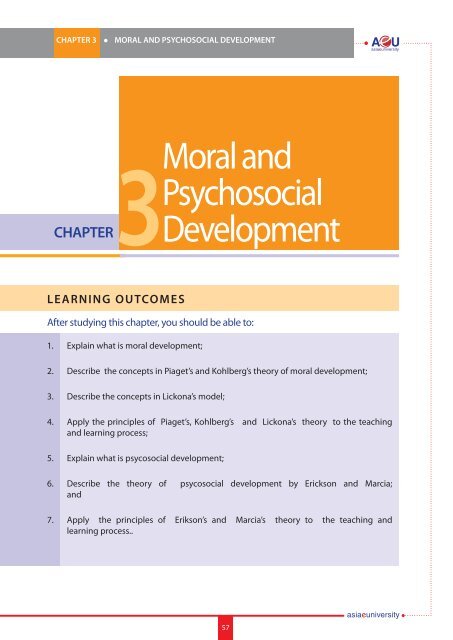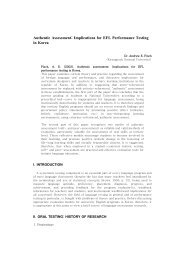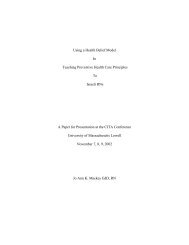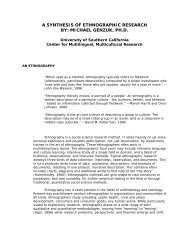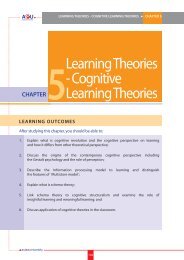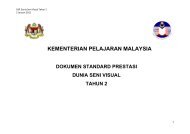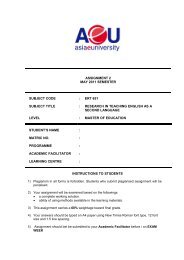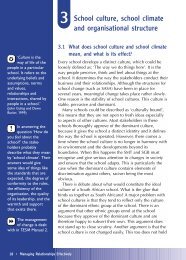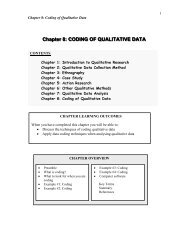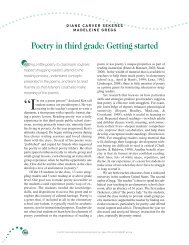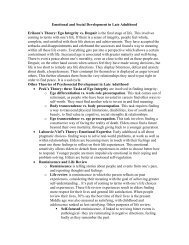Moral And Psychosocial Development CHAPTER
Moral And Psychosocial Development CHAPTER
Moral And Psychosocial Development CHAPTER
Create successful ePaper yourself
Turn your PDF publications into a flip-book with our unique Google optimized e-Paper software.
<strong>CHAPTER</strong> 3<br />
• MORAL AND PSYCHOSOCIAL DEVELOPMENT<br />
<strong>CHAPTER</strong><br />
<strong>Moral</strong> and<br />
<strong>Psychosocial</strong><br />
3<strong>Development</strong><br />
LEARNING OUTCOMES<br />
After studying this chapter, you should be able to:<br />
i.<br />
57<br />
1. Explain what is moral development;<br />
2. Describe the concepts in Piaget’s and Kohlberg’s theory of moral development;<br />
3. Describe the concepts in Lickona’s model;<br />
4. Apply the principles of Piaget’s, Kohlberg’s and Lickona’s theory to the teaching<br />
and learning process;<br />
5. Explain what is psycosocial development;<br />
6. Describe the theory of psycosocial development by Erickson and Marcia;<br />
and<br />
7. Apply the principles of Erikson’s and Marcia’s theory to the teaching and<br />
learning process..<br />
57
MORAL AND PSYCHOSOCIAL DEVELOPMENT • <strong>CHAPTER</strong> 3<br />
INTRODUCTION<br />
As a future educator, you need<br />
to understand the moral development<br />
of your students. Why?<br />
The answer is, as a classroom<br />
teacher, you are confronted<br />
with hundreds of issues<br />
pertaining to your students’<br />
moral reasoning each day.<br />
These may range from<br />
decisions they make about whether to cheat on a test to whether to be tolerant<br />
toward a classmate who is being picked on by others. Every day, your students make<br />
hundreds of comments and decisions that involve moral reasoning. Knowing how<br />
and when to respond, requires the teacher to understand the theory and principles underlying<br />
the process of moral development.<br />
Here are several theories and principles by psychologists related to the process of moral<br />
development as shown in Figure 3.1.<br />
Figure 3.1: Theories and principles related to the process of moral development<br />
58
<strong>CHAPTER</strong> 3<br />
• MORAL AND PSYCHOSOCIAL DEVELOPMENT<br />
3.1 <strong>Moral</strong> <strong>Development</strong><br />
3.1.1 Definition of <strong>Moral</strong> <strong>Development</strong><br />
According to Santrock,<br />
“<strong>Moral</strong> development concerns with rules and<br />
conventions about just interactions between<br />
people.”<br />
(Santrock, Educational Psychology, 2008: 102)<br />
These rules can be studied in 3 domains such as cognitive, behavioural and emotional. The<br />
descriptions of the 3 domains are shown in Figure 3.2.<br />
i.<br />
59<br />
Figure 3.2 : Descriptions for cognitive, behavioural and emotional in rules of moral development<br />
Look at the example below.<br />
Example:<br />
The strong guilty feeling in them when they want to cheat in a test, hinder them from doing<br />
the act.<br />
• <strong>Moral</strong> development in children develops through their moral reasoning.<br />
• <strong>Moral</strong> reasoning involve the thinking processes involved in judgments about question of<br />
right and wrong.<br />
59
MORAL AND PSYCHOSOCIAL DEVELOPMENT • <strong>CHAPTER</strong> 3<br />
In conclusion, Santrock says:<br />
“<strong>Moral</strong> development is the development that involves thoughts, feelings, and actions<br />
regarding rules and conventions about what people should do in their interactions<br />
with other people.”<br />
(Santrock, Life-Span <strong>Development</strong>, 2008: 279)<br />
3.1.2 Piaget’s Theory of <strong>Moral</strong> <strong>Development</strong><br />
Piaget (1932) proposed two stages of moral development<br />
that are heteronomous morality and autonomous morality.<br />
He derived his theory from observing, interviewing and<br />
quizzing the children on their thinking about game’s rules.<br />
He extensively observed and interview 4 to 12 years old<br />
children. He watchedthem play marbles, seeking to learn how<br />
they used and thought about the game’s rules.<br />
Jean Piaget (1896 - 1980)<br />
The Piaget’s 2 stages of moral development are shown in Figure 3.3:<br />
Figure 3.3: 2 stages in Piaget’s theory of moral development<br />
Stage 1- Heteronomous <strong>Moral</strong>ity (4 – 10 years old)<br />
• From 4 to 7 years of age, children display heteronomous morality.<br />
Children think of justice and rules as unchangeable properties<br />
of the world, remove from the control of people.<br />
• From 7 to 10 years of age, children are in transition<br />
showing some features of the first stage of moral<br />
reasoning and some features of the second stage,<br />
autonomous morality.<br />
• Because young children are heteronomous moralist, they<br />
60
<strong>CHAPTER</strong> 3<br />
• MORAL AND PSYCHOSOCIAL DEVELOPMENT<br />
judge the rightness or goodness of behaviour by considering its consequences, not the<br />
intensions of the actor.<br />
• For examples : Killing 10 birds accidentally is worse than killing 1 bird intentionally.<br />
Stage 2 - Autonomous <strong>Moral</strong>ity (10 years and above)<br />
• From about 10 years of age and older, children show<br />
autonomous morality. They became aware that rules and<br />
laws are created by people, and in judging an action. They<br />
consider the actor’s intensions as well as the consequences.<br />
• The older children, moral autonomist, accept change in<br />
rules example accept change in new rules of playing marbles<br />
suggested by Piaget, contrast with younger children, they<br />
resist change because they believes that rules are unchangeable.<br />
• So older children accept change in rules and recognize<br />
that rules are merely convenient conventions, subjects to<br />
change.<br />
Explain the two sages of moral development in Piaget’s theory.<br />
i.<br />
61<br />
http://faculty.mc3.edu/jhodges/PIAGETmoral%20theory%20.pdf<br />
3.2 Kohlberg’s Theory of <strong>Moral</strong> <strong>Development</strong><br />
A second major perspective on moral development was proposed<br />
by Lawrence Kohlberg (1958, 1986). Piaget’s stage of<br />
cognitive stages of development serve as the underpinnings<br />
for Kohlberg’s theory. Kohlberg arrived at his theory after<br />
interviewing children, adolescents, and adults (primarily males)<br />
about their views on a series of moral dilemmas. Here is an<br />
example of the type of dilemma he presented:<br />
Lawrence Kohlberg<br />
61
MORAL AND PSYCHOSOCIAL DEVELOPMENT • <strong>CHAPTER</strong> 3<br />
A woman is near death and is suffering from a special kind of cancer.<br />
There is only one drug that doctors think might save her. It was recently<br />
discovered by a druggist living in the same town as the woman. The drug<br />
was expensive to make, but the druggist is charging 10 times what the<br />
drug cost him to make. The sick woman’s husband, Heinz tries to borrow<br />
the money to buy the drug from every place he can think of but he can’t<br />
raise enough money. He tells the druggist that his wife is dying and asks him<br />
to sell it to him cheaper or let him pay later. But the druggist says, “No, I<br />
discovered it and I deserve to make money from it”. Later, Heinze get<br />
desperate, breaks in to the druggist store, and steals the drug for his wife.<br />
3.2.1 Kohlberg’s Level and Stages of <strong>Moral</strong> <strong>Development</strong><br />
Kohlberg constructed a theory of moral development that has 3 main levels with 2 stages at<br />
each of the level as shown in Table 3.1.<br />
Table 3.1: Levels and Stages in Kohlberg’s Theory of <strong>Development</strong><br />
Level and Stage<br />
Description<br />
Level 1<br />
Preconventional<br />
Reasoning<br />
• The ethics of egocentricity.<br />
• Typical of children up to about age 10.<br />
• Called preconventional because young children don’t really<br />
comprehend the rules set down by others.<br />
• The consequences of the act determine if it is good or bad.<br />
Stage 1:<br />
Punishment-<br />
Obedience<br />
• The ethics of “ What’s in it for me?”<br />
Stage 2:<br />
Market Exchange<br />
• Obeying rules and exchanging favors<br />
are judged in terms of benefit to the<br />
person.<br />
Level 2<br />
Conventional Ethics<br />
• The ethics of others.<br />
• Typical of ten to twenty years olds.<br />
• The names come from conformity to the rules and conventions<br />
of society.<br />
Stage 3:<br />
Interpersonal<br />
Harmony<br />
• Sometimes called “Nice girl/Good boy”<br />
• Ethical decisions are based on what<br />
pleases, helps, or is approved of others.<br />
62
<strong>CHAPTER</strong> 3<br />
• MORAL AND PSYCHOSOCIAL DEVELOPMENT<br />
Stage 4:<br />
Law and Order<br />
• The ethics of order.<br />
• Right is doing one’s duty, obeying<br />
the law, and maintaining an orderly<br />
society.<br />
Level 3<br />
Postconventional<br />
Ethics<br />
• The ethics of principle.<br />
• Rarely reached before age twenty and only by a small segment of<br />
the population.<br />
• Focuses on the principles underlying society’s rules.<br />
Stage 5:<br />
Social Contract<br />
• Rules are based on principles of justice<br />
and common good and are mutually<br />
agreed upon by members of society.<br />
Stage 6:<br />
Universal Principles<br />
• Rarely encountered in life.<br />
• Ethics determine by individual’s<br />
conscience guided by the abstract<br />
principles of justice and equality.<br />
Source: From Lawrence Kohlberg, 1984 in Tan et. al. (2003) page 83.<br />
3.2.1.1 Level 1: Preconventional <strong>Moral</strong>ity<br />
<strong>Moral</strong>ity at this stage is determined by the consequences of an action rather than by the<br />
inherent goodness or badness of an act. This level consists of 2 stages as shown in Figure 3.4:<br />
i.<br />
63<br />
Figure 3.4 : 2 stages in Preconventional <strong>Moral</strong>ity<br />
That is, they reason that an act is moral if the consequence of obeying a rule results in their<br />
obtaining something positive. A child reasoning at this hedonistic stage may argue that<br />
Heinz was right in stealing the drug if he left a note promising to do a favour for the druggist.<br />
63
MORAL AND PSYCHOSOCIAL DEVELOPMENT • <strong>CHAPTER</strong> 3<br />
3.2.1.2 Level 2: Conventional <strong>Moral</strong>ity<br />
As egocentrism continues to decline, the child increasingly views moral issues from the<br />
perspective of others. Rather than viewing morality in terms of immediate concrete<br />
consequences, the individual now make moral decisions by considering factors of a less<br />
concrete and more social nature, such as the approval of others, family loyalty, obedience to<br />
the law, and social order. Individuals operating at the conventional level, have internalized<br />
the rules or, if you will, the “conventions” of society.<br />
This level of moral reasoning consists of 2 stages as shown in figure 3.5:<br />
Figure 3.5 : 2 stages in Conventional <strong>Moral</strong>ity<br />
3.2.1.3 Level 3: Post Conventional <strong>Moral</strong>ity<br />
At this level, individuals begin to focus on the principles that underlie these rules. Comparatively<br />
few people reach Kohlberg’s third level of moral reasoning. This level is made up<br />
of 2 stages as shown in figure 3.6:<br />
64
<strong>CHAPTER</strong> 3<br />
• MORAL AND PSYCHOSOCIAL DEVELOPMENT<br />
Figure 3.6 : 2 stages in Post Conventional <strong>Moral</strong>ity<br />
1. Explain the three levels and stages in Kohlberg’s moral development<br />
theory.<br />
2. What is the major moral issue face by the adolescent in conventional<br />
stage?<br />
3.3 Lickona’s Model – <strong>Moral</strong> Reasoning<br />
to <strong>Moral</strong> Behaviour<br />
Dr. Thomas Lickona<br />
Understanding our students’ moral reasoning will certainly assist us<br />
in both understanding their decisions pertaining to moral issues and<br />
in maintaining good behaviour.<br />
The Lickona’s model proposes 4 components programmes designed<br />
to facilitate moral behaviour. The 4 components include self-esteem,<br />
cooperative learning, moral reflection and participatory decision<br />
making as shown in figure 3.7.<br />
i.<br />
65<br />
Figure 3.7: 4 components programmes designed to facilitate moral behaviour in Lickona’s Model.<br />
65
MORAL AND PSYCHOSOCIAL DEVELOPMENT • <strong>CHAPTER</strong> 3<br />
Lickona has collected data that demonstrate the systematic use of this model produces an<br />
increase in moral behaviour among students. Let us consider the implementation of this<br />
model in the classroom.<br />
3.3.1 Self-Esteem<br />
Lickona (1983) defines self-esteem as a student’s<br />
sense of mastery or competence. He contends<br />
that, showing students that you respect their<br />
uniqueness as individuals is a powerful<br />
way to raise self-esteem. Higherselfesteem,<br />
leads to the greater likelihood of<br />
moral behaviours. Lickona suggested<br />
two ways to promote self-esteem in<br />
students:<br />
• First, learn at least one unique positive<br />
character or personality traits in<br />
each one of your students early in the<br />
school year. Teachers must try to recognize and praise positive character that a student<br />
has in order to help the student to maintain it.<br />
• Second, teachers find ways to recognize moral behaviours that the student already<br />
engaged in such as making positive comments on student’s power point presentation.<br />
3.3.2 Cooperative Learning<br />
Lickona contends that cooperative learning is also<br />
linked with promoting moral behaviour, especially<br />
helping or prosocial behaviour. He defines cooperative<br />
learning as students learning from and<br />
with each other. Lickona recommends 2<br />
strategies helpful in promoting prosocial<br />
behaviour.<br />
• Teachers should start out in classes, which<br />
is unfamiliar with cooperative learning<br />
approaches by having students work in groups.<br />
• Use an affirmation exercise in which students publicly affirm how someone else in the<br />
class helped them that day or week.<br />
He cautions that such a practice may involve several weeks to model and teach to students,<br />
since many students are not in the habit of saying something positive about their peers.<br />
66
<strong>CHAPTER</strong> 3<br />
• MORAL AND PSYCHOSOCIAL DEVELOPMENT<br />
3.2.1.3 Level 3: Post Conventional <strong>Moral</strong>ity<br />
At this level, individuals begin to focus on the principles that underlie these rules. Comparatively<br />
few people reach Kohlberg’s third level of moral reasoning. This level is made up<br />
of 2 stages as shown in figure 3.6:<br />
For example:<br />
A Secondary Four literature teacher covering the war poets gave her students<br />
the opportunity to turn the classroom into a war zone complete with<br />
tents, helmets, army uniforms and other army paraphernalia on display.<br />
3.3.4 Participatory Decision-Making<br />
Participatory decision-making means<br />
allowing students to participate in making<br />
decisions, which affect the quality of<br />
classroom life. Lickona contends that<br />
the more students are able to help make<br />
these decisions, the more students<br />
will exhibit moral behaviours as they<br />
begin to feel a sense of ownership in<br />
the rules that govern how the classroom<br />
works. Lickona suggests that holding class<br />
meeings in which students brainstorm a<br />
number of solutions related to these issues may be a useful first step in instilling a sense<br />
of ownership in the decision–making process.<br />
According to Castle & Rogers<br />
i.<br />
67<br />
The concept of participatory decision-making involves the creation of a<br />
constructivist classroom in which students actively participate in the construction<br />
of classroom rules.<br />
Castle & Rogers, 1993/1994.<br />
Discuss how teacher can apply the four component of <strong>Moral</strong> Reasoning<br />
in Lickona Model (1983) in teaching and learning process.<br />
67
MORAL AND PSYCHOSOCIAL DEVELOPMENT • <strong>CHAPTER</strong> 3<br />
3.4 Erikson’s Theory of <strong>Psychosocial</strong> <strong>Development</strong><br />
In Erikson’s theory of psychosocial development, Erikson highlighted<br />
the importance of relationship with others in the formation of one’s<br />
own identity. Erikson believed that personality develops through eight<br />
stages or critical periods of life as shown in Table 3.2.<br />
Erikson<br />
Table 3.2: Stages In Erikson’s Theory of <strong>Psychosocial</strong> <strong>Development</strong><br />
Stages<br />
Stages 1<br />
Trust versus Mistrust.<br />
Stages 2<br />
Autonomy versus<br />
Shame and Doubt.<br />
Stages 3<br />
Initiative versus Guilt.<br />
Stages 4<br />
Industry versus<br />
Inferiority.<br />
Stages 5<br />
Identity versus Role<br />
Confusion.<br />
Stages 6<br />
Intimacy versus<br />
Isolation.<br />
Stages 7<br />
Generativity versus<br />
Stagnation.<br />
Stages 8<br />
Integrity versus Despair.<br />
Ages<br />
Birth to one year<br />
One to three years<br />
Four to five years<br />
Six to Eleven years<br />
Twelve to eighteen years<br />
Eighteen to thirty<br />
five years<br />
Thirty five to<br />
sixty five years<br />
Over sixty five years<br />
Description<br />
A child have to develop a sense of<br />
trust in others.<br />
The children want to do things<br />
autonomously.<br />
The children develop a sense<br />
of initiative, explore and<br />
investigate.<br />
The children go to school, learn<br />
reading, writing and counting;<br />
eager to produce good work.<br />
Adolescent have to develop<br />
self-identity. Look up for role<br />
model.<br />
Adolescent try to develop true<br />
and intimate relationship with<br />
opposite sex friends.<br />
Married couple taking good<br />
care and well-being of next<br />
generation.<br />
Old couple review their life<br />
with a sense of satisfaction and<br />
acceptance. Their lives have<br />
been fruitful, achieve a sense of<br />
integrity.<br />
68
<strong>CHAPTER</strong> 3<br />
• MORAL AND PSYCHOSOCIAL DEVELOPMENT<br />
He also contended that at each stage of life, an individual is confronted by a crisis. Erikson<br />
assume the personality develops in accordance to one’s ability to interact with the<br />
environment and to resolve the crises experienced. The manner in which the crises are<br />
resolved will have a lasting effect on the person’s view of him or herself and the surrounding<br />
world.<br />
Stage 1 : Trust versus Mistrust (Birth to One Year)<br />
• The first psychological challenge faced by a child involves developing<br />
a sense of trust in others. For the infant, this sense of trust develops<br />
if she is predictably cared for when she cries and is warmly treated by<br />
her primary caregivers. If an infant, instead, is cared for in unpredictable<br />
ways such as not being fed, diapered, or comforted when necessary,<br />
Erikson believed this infant would develop basic mistrust of others,<br />
which would lead to fear and suspicion.<br />
Stage 1<br />
• One implication for practice is for teachers to develop predictable,<br />
consistent classroom routines. It will make the students’ feel the<br />
classroom is a safe place for them to study and make friends.<br />
• Teachers must always show their genuine concern over student’s<br />
best interest and make them feel that classroom are safe and loving<br />
place. Decorate the classroom with the students.<br />
• Give opportunity for the students to speak in front of the class or<br />
write on the whiteboard.<br />
• Give a clap when the student answer questions correctly.<br />
• Classroom teacher must be friendly with the students and<br />
communicate with them often.<br />
i.<br />
69<br />
Stage 2 : Autonomy versus Shame and Doubt (Ages One to Three)<br />
• At ages two and above, children want to do things on their own or act<br />
autonomously. Yet this need to become autonomous must be balanced<br />
by the reality of safety issues.<br />
Stage 2<br />
• For instance, while Erikson thought it was healthy to allow the two-yearolds<br />
to explore the streets alone, this exploration must be done in a constraint<br />
way such that the child is not hit by a car. Therefore, Erikson called<br />
for a delicate interplay between freedom and restraint.<br />
• As for teachers, their role is to provide safe areas for physical as well as<br />
social exploration so that children can practice being autonomous.<br />
69
MORAL AND PSYCHOSOCIAL DEVELOPMENT • <strong>CHAPTER</strong> 3<br />
• Several educational implication follow.<br />
- First, when teacher must impose restrictions, never humiliate a child<br />
either physically or verbally.<br />
- Second, provide young children with adequate opportunities to<br />
do things for themselves, no matter how messy it would be.<br />
- Third, set up discipline in which the same consequence is<br />
administered consistently each time a rule is broken. This gives<br />
the child a sense of a secure and ordered world.<br />
Stage 3 : Initiative versus Guilt (Ages Four to Five)<br />
Stage 3<br />
• Erikson contends that children when face with new challenges, will<br />
want to explore and investigate. He termed this the development<br />
of a sense of initiative, whereby children begin to ask many<br />
questions about the world.<br />
• The ever-present questions of “why” and “what” seem to engulf a<br />
child at this stage as do the inquisitive behaviours that often<br />
accompany taking initiative.<br />
• For instance, children may ask question about and want to help<br />
with work in the kitchen. In situations in which a child is discouraged<br />
from taking the initiative, Erikson believed that the child would<br />
develop a sense of guilt regarding her natural tendency to explore<br />
and investigate.<br />
• According to tan “A number of implications follow for teachers<br />
(Tan 2003: 94)”.<br />
- First, praise children you work with for taking the initiative.<br />
- A second implication involves the use of developmentally<br />
approriate curriculum in which students have the chance to<br />
develop the necessary muscular coordination needed to<br />
manipulate the toys and other objects.<br />
- A third implication is to provide this age group with plenty of<br />
opportunities to play.<br />
Stage 4 : Industry versus Inferiority (Age Six to Eleven)<br />
Stage 4<br />
• The major psychological task in the fourth stage is the<br />
development of competence or industry. The term industry<br />
means in this stage children not only continues their interest in<br />
trying new things, but they will try to succeed in learning and gain<br />
recognition for producing things or good result.<br />
• In this stage of development, which last throughout the<br />
elementary school years, children are faced with the challenges<br />
70
<strong>CHAPTER</strong> 3<br />
• MORAL AND PSYCHOSOCIAL DEVELOPMENT<br />
of producing good acdemic work related to reading, writing, and<br />
mathematical skills.<br />
• Children also face the challenges to be competence in hobby,<br />
playing sports, maintaining a positive relationship with teachers,<br />
and developing friendship. Recent research has shown that social<br />
skills training as well as attention to social problem solving can<br />
be helpful in terms of developing social competence in forming<br />
friendships and developing social skills.<br />
• Children who leave the elementary years without this sense of<br />
industry, may feel they are failure at everything. So it is the<br />
responsbility of parents and teachers to help them to become<br />
academically and socially competence.<br />
Stage 5 : Identity versus Role Confusion (Ages Twelve to Eighteen)<br />
• Erikson’s fifth stage of psychosocial development is for the<br />
secondary and post-secondary school students. The major<br />
psychological task is to gain self identity.<br />
• In this stage, adolescents struggle to resolove the questions of<br />
“Who am I?” and “Who will I become”. That is why they move<br />
increasingly from their parents to peers as apoint of reference,<br />
they need to understand how they are both alike and at the same<br />
time uniquely different from everyone else.<br />
i.<br />
71<br />
Stage 5<br />
• Physical appearance play important role in development of<br />
personal identity. For girls personal identity concerns including<br />
clothing, make-up, ways of walking and ways of dressing. Along<br />
with this search for ideal physical appearance is the advent of the<br />
personal fable and imagery audience.<br />
• Personal fable is the self-generated, often romanticized story of<br />
one’s personal destiny. The adolescent may develop an image of<br />
him-or-herself that protends a destiny, a life story as a great hero,<br />
rock star, or the great reformer of the world’s evils.<br />
• The potential danger of this notion is that the adolescents think<br />
he is invincible and that despite the recognition that bad things<br />
happen to others, they will not happen to him. This notion which is<br />
not true and the adolescents will suffer the same consequences if<br />
they involve in risk taking behaviour.<br />
• Imagery audience is part of adolescent egocentrism, implies that the<br />
adolescent assumes that others are focused upon and concerned<br />
about the same issues which he personally feels so important such as<br />
71
MORAL AND PSYCHOSOCIAL DEVELOPMENT • <strong>CHAPTER</strong> 3<br />
the ways of dressing.<br />
• The adolescents also strive to find their own personalities. They<br />
need a figure or model to identify with. That’s why the adolescents<br />
often imitate the attitudes and actions of others they admire.<br />
• Adolescents also face the issues of sexual identity that is the<br />
adolescent searches for comfortable expressions of sexuality<br />
through friendship and dating.<br />
• This in fact is the most difficult time in everyone’s life. Teachers<br />
and parents have to be patience with the adolescents and guide<br />
them to cope effectively with the crises they are facing.<br />
• Parents and teachers should give the adolescent opportunity to<br />
explore different jobs such as working temporarily in fast food<br />
restaurant, become the chef of a restaurant, work in a bank, work<br />
in a factory etc.<br />
Stage 6 : Intimacy versus Isolation (Ages Eighteen to Thirty-five)<br />
Stage 6<br />
• The major psychosocial crisis in Erikson’s six stage is the<br />
development of a true and intimate heterosexual relationship.<br />
Erikson contends that in this stage individuals should be able to<br />
care for others without losing their self-identity.<br />
• Erikson believes individual who never know this intimacy will<br />
develop a sense of isolation and tend to avoid relationships with<br />
others and make commitments.<br />
• This six stages crises faced mostly by college and university<br />
students. One of the ways for the adolescents to face this crisis is to<br />
be active in sports, clubs and participate in community social works.<br />
Stage 7 : Generativity versus Stagnation (Thirty-five to Sixty-five)<br />
• The major concern of the people at this age is on the caring and<br />
well-being of the next generation rather than being overly<br />
sef-concerned.<br />
Stage 7<br />
• Most parents focused their energy and time on bringing up<br />
their children to be succesful academically, socially and emotionally.<br />
• Erikson argued that if a sense of generativity is not present, the<br />
individual would experience stagnation and become overly selfpreoccupied.<br />
72
<strong>CHAPTER</strong> 3<br />
• MORAL AND PSYCHOSOCIAL DEVELOPMENT<br />
Stage 8 : Integrity versus Despair (Over Sixty-five)<br />
Stage 8<br />
• In this last stage, individuals who have managed to adapt to the<br />
triumphs and tragedies of life are able to review their lives<br />
with a sense of satisfaction and acceptance which Erikson thought<br />
to be a prerequisite to achieving a sense of integrity at the end’s<br />
of one’s life. Others who have failed will be absorbed with<br />
despairing over missed oppurtunities, age and failure.<br />
• For those who have achieved a sense of satisfaction in life, it can<br />
be well-pictured during celebration such as Hari Raya, Chinese<br />
New Year and Deepavali as those who will be surrounded by<br />
their children and grandchildren, and have happy moments<br />
together year by year until they deceased.<br />
Describe the specific stage when adolescents are faced with crisis to<br />
develop their own identity.<br />
3.5 James Marcia’s Identity Status Theory<br />
i.<br />
73<br />
Erikson had suggested that the normative conflict occurring in<br />
adolescence is the opposition between identity and confusion<br />
(identity crisis). Marcia elaborated on Erikson’s proposal by<br />
suggesting this stage consists neither of identity resolution<br />
nor identity confusion as Erikson claimed, but the extent to<br />
which one both has explored and committed to an identity in a<br />
variety of life domains including politics, occupation, religion,<br />
intimate relationships, friendships, and gender roles.<br />
James Marcia, Canadian<br />
<strong>Development</strong>al psychologist<br />
His Theory of Identity Achievement states that there are 2 distinct parts that form<br />
adolescent’s identity:<br />
• a crisis<br />
• a commitment<br />
He defined a crisis as a time of upheaval where old values or choices are being<br />
re-examined. The outcome of a crisis leads to a commitment to a certain value or role.<br />
James Marcia expanded on Erikson’s work and divided the identity crisis into 4 states.<br />
These are not stages, but rather processes that adolescents go through. All adolescents will<br />
occupy one or more of these states, at least temporarily. But, because these are not stages,<br />
73
MORAL AND PSYCHOSOCIAL DEVELOPMENT • <strong>CHAPTER</strong> 3<br />
people do not progress from one step to the next in a fixed sequence, nor must everyone<br />
go through each and every state. Each state is determined by two factors:<br />
• Is the adolescent committed to an identity?<br />
• Is the individual searching for his true identity?<br />
To better understand the identity formation process, Marcia<br />
conducted interviews with young people. He asked whether<br />
the participants in his study had established a commitment<br />
to an occupation and ideology and had experienced, or<br />
were presently experiencing, a decision making period<br />
(adolescent identity crisis). Marcia developed a framework<br />
for thinking about identity in terms of 4 identity statuses. It is important to note that these<br />
are NOT stages. Identity statuses should not be viewed as substages in a sequential or<br />
linear process as shown in Table 3.3.<br />
Table 3.3 : 4 states in James Marcia’s Identity Status Theory<br />
Identity Statuses<br />
1) Identity foreclosure<br />
2) Identity Moratorium<br />
3) Identity Diffusion<br />
4) Identity Achievement<br />
Description<br />
When the adolescent selects a convenient set of<br />
belief and goals without carefully considering the<br />
alternatives an example would be accepting one’s<br />
parents’ choice of life-style and career.<br />
When the adolescent considers alternative choices,<br />
experiences different roles but has not made final<br />
decision regarding his/her identity.<br />
When adolescent has not made any firm commitments to any<br />
ideology, occupation, or interpersonal relationship and is not<br />
currently thinking about such commitments.<br />
When the adolescent has a strong sense of commitment to life<br />
choices after careful consideration of options.<br />
74
<strong>CHAPTER</strong> 3<br />
• MORAL AND PSYCHOSOCIAL DEVELOPMENT<br />
a) Identity Foreclosure<br />
Identity foreclosure means that the adolescent blindly accepts the identity and values that<br />
were given in childhood by families and significant others. The adolescent’s identity is<br />
foreclosed until they determine for themselves their true identity. The adolescent in this state<br />
is committed to an identity but not as a result of their own searching or crisis.<br />
These people have made commitments to an occupational future, but have not experienced<br />
an identity crisis. They have conformed to the expectations of others concerning their future.<br />
• For example, an individual may have allowed a parent to decide what career they will<br />
pursue. These individuals have not explored a range of options (experience an “identity<br />
crisis”).<br />
b) Identity Moratorium<br />
Adolescent has acquired vague or ill-formed ideological<br />
and occupational commitments. He or she is still undergoing<br />
the identity search (crisis). They are beginning to commit<br />
to an identity but are still developing it. Individuals in<br />
moratorium are actively exploring alternative commitments, New Identity<br />
but have not yet made a decision. They are experiencing<br />
an identity crisis, but appear to be moving forward toward identity formation, making<br />
commitments.<br />
c) Identity Diffusion<br />
Diffusion is the state of having no clear idea of one’s identity<br />
and making no attempt to find that identity. These<br />
adolescents may have struggled to find their identity, but<br />
they never resolved it, and they seem to have stopped<br />
trying. There is no commitment and no searching. The<br />
young person has not made a commitment, and may or<br />
may not have experienced an identity crisis. He or she<br />
appears to have given up any attempt to make the commitments needed for developing<br />
a clear sense of identity as Marcia defines the term.<br />
i.<br />
75<br />
d) Identity Achievement<br />
The state of having developed well-defined personal<br />
values and self-concepts. Their identities may be expanded<br />
and further defined in adulthood, but the basics are there.<br />
They are committed to an ideology and have a strong sense<br />
of ego identity. The individual has experienced an identity<br />
crisis and has made commitments necessary for building a<br />
sense of identity as described above.<br />
75
MORAL AND PSYCHOSOCIAL DEVELOPMENT • <strong>CHAPTER</strong> 3<br />
Note that, the above statuses are not stages and should not beviewed as a sequential<br />
process. The core idea is that one’s sense of identity is determined largely by the choices<br />
and commitments made regarding certain personal and social traits. The work done in<br />
this paradigm considers how much one has made certain choices, and how much he or<br />
she displays a commitment to those choices. Identity involves the adoption of a sexual<br />
orientation, a set of values and ideals and a vocational direction. A well-developed<br />
identity gives an individual a sense of strengths, weaknesses, and individual uniqueness.<br />
A person with a less well-developed identity is not able to define his or her personal<br />
strengths and weaknesses, and does not have a well-articulated sense of self. Figure 3.8<br />
shows 3 elements in Identity based on Marcia’s Theory.<br />
Sexual<br />
orientation<br />
Element in identity<br />
Set of values<br />
and ideals<br />
Vocational<br />
direction<br />
Figure3.4: Element in Identity regarding to Marcia’s theory<br />
James Marcia’s have comfounded a theory of identiy statuses. Describe<br />
the four identity statuses.<br />
3.6 Carol Gilligan’s <strong>Moral</strong> <strong>Development</strong> Theory<br />
One theorist, Carol Gilligan, found that morality is developed by looking at much more<br />
than justice. The following will discuss the <strong>Moral</strong>ity <strong>Development</strong> Theory of Carol<br />
Gilligan and its implications.<br />
“As human beings grow, we somehow develop the ability to assess what is right<br />
or wrong, acceptable or unacceptable. In other words, we develop morality,<br />
a system of learned attitudes about social practices, institutions, and individual<br />
behavior used to evaluate situations and behavior as good or bad, right or<br />
wrong.”<br />
(Lefton, 2000).<br />
76
<strong>CHAPTER</strong> 3<br />
• MORAL AND PSYCHOSOCIAL DEVELOPMENT<br />
Carol Gilligan was the first to consider gender differences in her<br />
research with the mental processes of males and females in their moral<br />
development. In general, Gilligan noted differences between girls and<br />
boys in their feelings towards caring, relationships, and connections<br />
with other people.<br />
Carol Gilligan<br />
More specifically, Gilligan noted that girls are more concerned<br />
with care, relationships, and connections with other people<br />
than boys (Lefton, 2000). Thus, Gilligan<br />
hypothesized that young girls are more<br />
inclined toward caring and young boys<br />
are more inclined toward justice<br />
(Lefton, 2000). Gilligan suggested<br />
these differences due to gender<br />
and the child’s relationship with<br />
the mother (Lefton, 2000).<br />
Gilligan found that girls do<br />
in fact develop moral orientations<br />
differently than boys. According to Gilligan, the central moral problem for women is<br />
the conflict between self and others. Within Gilligan’s theoretical framework for moral<br />
development in females, she provided a sequence of 3 levels, illustrated in Table 3.4.<br />
Table 3.4: Carol Gilligan’s <strong>Moral</strong> <strong>Development</strong> Theory<br />
i.<br />
77<br />
Level<br />
Level 1<br />
Orientation to<br />
Individual Survival<br />
Here, decision centre on the self, and concerns are pragmatic.<br />
First Transition<br />
From Selfishness to<br />
Responsibility<br />
Description<br />
As attachment to others appears;<br />
self-interest is redefined in light<br />
of “what one should do.”<br />
A sense of responsibility for others appears (the traditional view<br />
of women as caretakers). Goodness is equated with self-sacrifice<br />
and concern for others.<br />
Level II<br />
Goodness as<br />
Self-Sacrifice<br />
Second Transition<br />
From Goodness<br />
to Truth<br />
Women begin to conclude concern<br />
for self with their concern for others.<br />
It is possible to be responsible to<br />
one’s self as well as to others? The<br />
answer requires knowledge, hence<br />
the shift from goodness to truth.<br />
Recognizing one’s needs is not being<br />
selfish but rather being honest and fair.<br />
77
MORAL AND PSYCHOSOCIAL DEVELOPMENT • <strong>CHAPTER</strong> 3<br />
Level III<br />
The <strong>Moral</strong>ity of Nonviolence<br />
Resolution of the conflict between concern for self and concern<br />
for others results in a guiding principle of non-violence. Harmony<br />
and compassion govern all moral action involving self and others.<br />
Level III defines both femininity and adulthood.<br />
3.6.1 Levels in Carol Gilligan’s <strong>Moral</strong> <strong>Development</strong> Theory<br />
Carol Gilligan’s moral development theory consisted of 3 levels as explained below:<br />
• At level one of Gilligan’s theoretical framework, a woman’s<br />
orientation is toward individual survival, the self is the sole<br />
object of concern. The first transition that takes place is<br />
from being selfish to being responsible.<br />
• At level two, the main concern is that goodness is<br />
equated with self-sacrifice. This level is where a woman<br />
adopts societal values and social membership. Gilligan<br />
refers to the second transition from level two to level<br />
three as the transition from goodness to truth. Here, the<br />
needs of the self must be deliberately uncovered, and as<br />
they are uncovered the woman begins to consider the<br />
consequences of the self and others.<br />
Gilligan’s theory contributed a great deal of information about the differences with the<br />
mental processes of males and females in their moral development. However, it still has<br />
positive and negative implications in the field of psychology. Figure 3.9 shows some<br />
implications of Gilligan’s theory in the field of psychology.<br />
Positive implications<br />
• Gilligan’s theory has influenced other psychologists in their<br />
evaluations of morality.<br />
• Gilligan’s work highlights that people think about other<br />
people in a humanly caring way.<br />
• Gilligan emphasized that both men and women think<br />
about caring when faced with relationship dilemmas,<br />
similarly both are likely to focus on justice when faced with<br />
dilemmas involving others rights.<br />
Negative implications<br />
• The most criticized element to Gilligan’s theory is that it<br />
follows the stereotype of women as nurturing, men as logical.<br />
Figure 3.9 Positive and negative implications of Gilligan’s Theory in the field of psychology.<br />
78
<strong>CHAPTER</strong> 3<br />
• MORAL AND PSYCHOSOCIAL DEVELOPMENT<br />
The participants of Gilligan’s research are limited to mostly white, middle class children<br />
and adults (Woods, 1996). In general, literature reviews have provided that Gilligan’s<br />
work needs a broader multicultural basis.<br />
In summary, Carol Gilligan has provided a framework for the moral orientations and<br />
development of women. Current research on explicit schemas as to how women come to<br />
real-life decisions when faced with real-life dilemmas is limited. Gilligan’s theory comprises<br />
3 stages: self-interest, self-sacrifice, and post-conventional thinking where each level is<br />
more complex.<br />
Discuss Gilligan’s theory of moral development for women.<br />
SUMMARY<br />
• <strong>Moral</strong> development is the development that involves thoughts, feelings, and actions<br />
regarding rules and conventions about what people should do in their interactions with<br />
other people.<br />
• Piaget (1932) proposed two stages theory of moral development:<br />
- Heteronomous morality, experiences by children below ten years old,<br />
- Autonomous morality, experiences by children above ten years old.<br />
• Kohlberg’s theory of moral development consists of three levels and six stages. The<br />
three levels are preconventional, conventional and post-conventional.<br />
• The concepts in Lickona’s model are self esteem, cooperative learning, self reflection<br />
and participatory decision making.<br />
• Principles that underlie Piaget’s and Kohlberg’s theory and Lickona’s model can be<br />
applied in resolving issues on morality in the classroom.<br />
• Erickson’s psychosocial development theory consists of eight stages. At each stage<br />
individual has to resolve crisis in order to obtain his or her self identity.<br />
• Marcia’s contended identity statuses theory comprising 4 identity statuses are as follows:<br />
(1) identity foreclosure (2) identity moratorium (3) identity diffusion and (4) identity<br />
achievement.<br />
• Gilligan’s theory of woman’s moral development consists of 3 levels as follows:<br />
- Orientation to individual survival.<br />
- Goodness as self-sacrifice.<br />
- The morality of Non-violence.<br />
i.<br />
79<br />
79
MORAL AND PSYCHOSOCIAL DEVELOPMENT • <strong>CHAPTER</strong> 3<br />
KEY TERMS AND CONCEPTS<br />
Terms<br />
Definitions<br />
Autonomous morality<br />
Conventional morality<br />
Cooperative learning<br />
Egocentrism<br />
Foreclosure<br />
Hedonism<br />
Heteronomous morality<br />
Identity moratorium<br />
Imagery audience<br />
From about 10 years of age and older, children<br />
became aware that rules and laws are created<br />
by people, and in judging an action, they<br />
consider the actor’s intensions as well as the<br />
consequences. They accept change in the rules.<br />
The adolescents and adults conform to the rules<br />
and conventions of society.<br />
The assignment of students of varying abilities<br />
and ethnicities and of both genders to small<br />
groups with a common goal in which each<br />
member has a role.<br />
The naïve belief that your point of view or visual<br />
perspective is shared by others.<br />
Individuals who would be accepting one’s<br />
parents’ choice of life-style and career.<br />
The theory that individuals are motivated<br />
primarily by the desire to seek pleasure and<br />
avoid pain.<br />
Children think of justice and rules as<br />
unchangeable properties of the world, remove<br />
from the control of people. Children display<br />
heteronomous morality from 4 to 7 years of age.<br />
When the adolescent considers alternative<br />
choices, experiences different roles but has not<br />
made final decision regarding his/her identity.<br />
Part of adolescent egocentrism, implies that the<br />
adolescent assumes that others are focused upon<br />
and concerned about the same issues which he<br />
personally feels so important such as the ways of<br />
dressing.<br />
80
<strong>CHAPTER</strong> 3<br />
• MORAL AND PSYCHOSOCIAL DEVELOPMENT<br />
Integrity<br />
Individuals who have managed to adapt to<br />
the triumphs and tragedies of life are able to<br />
review their lives with a sense of satisfaction<br />
and acceptance which Erikson thought to be a<br />
prerequisite to achieving a sense of integrity at<br />
the end’s of one’s life.<br />
<strong>Moral</strong> development<br />
The development that involves thoughts,<br />
feelings, and actions regarding rules and<br />
conventions about what people should do in<br />
their interactions with other people.<br />
Participatory decision<br />
making<br />
Allowing students to participate in making<br />
decisions which affect the quality of classroom<br />
life.<br />
Personal fable<br />
The self-generated, often romanticized story<br />
of one’s personal destiny. The adolescent may<br />
develop an image of him-or-herself that protends<br />
a destiny.<br />
Postconventional<br />
morality<br />
At this level, individuals begin to focus on the<br />
principles that underlie this rules.<br />
i.<br />
81<br />
Preconventional morality<br />
<strong>Moral</strong>ity at this stage is determined by the<br />
consequences of an action rather than by the<br />
inherent goodness or badness of an act.<br />
Reciprocity<br />
The reason that an act is moral if the<br />
consequence of obeying a rule results in their<br />
obtaining something positive.<br />
81
MORAL AND PSYCHOSOCIAL DEVELOPMENT • <strong>CHAPTER</strong> 3<br />
ENDNOTES<br />
1. Belknap, R.A. (2000). One woman’s life viewed through the interpretive lens of<br />
Gilligan’s theory. Violence Against Women, 6, 586-605.<br />
2. Gilligan, C., & Attanucci, J. (1988). Two moral orientations: Gender differences and<br />
similarities. Merrill-Palmer Quarterly, 34, 223-237.<br />
3. Lefton, L. A. (2000). Child <strong>Development</strong>. In Psychology, (7 th ed.) pp. 350-351, Allyn<br />
& Bacon publishing.<br />
4. Ormrod, J. E. 2006. Educational psychology developing learners. 5 th ed. New Jersey:<br />
Prentice Hall.<br />
5. Santrock, J. W. 2008. Educational psychology. 3 rd ed. Boston: McGraw-Hill.<br />
6. Tan O. S., Parsons, R. D., Hinson, S. L. & Sardo-Brown, D. 2003. Educational<br />
psychology a practitioner-researcher approach. Australia: Thomson.<br />
7. Woolfolk, A. 2007. Educational psychology. 10 th ed. Boston: Pearson.<br />
References from the Internet:<br />
http:// www..psy.pdx.edu/PsiCafe/Key Theorists/Kohlberg.htm<br />
http://ww.e-psikologi.com/remaja/210602.htm<br />
http://www.pustekkom.go.id/teknodik/9-5/htm<br />
http://www.nd.edu/rbarger/kolberg.htm<br />
http://socialscientist.us/nphs/psychIB/psychpdfs/Marcia.<br />
http://www.unm.edu/~jka/courses/archive/ident.html<br />
http://www.learning-theories.com/identity-status-theory-marcia.html<br />
http://en.wikipedia.org/wiki/James_Marcia<br />
82
<strong>CHAPTER</strong> 3<br />
• MORAL AND PSYCHOSOCIAL DEVELOPMENT<br />
Review and Discussion Questions<br />
1. The definition of moral development is __________.<br />
A. the development that involves thoughts, feelings, and actions regarding rules<br />
and conventions about what people should do in their interactions with other<br />
people.<br />
B. the development of psycososial that involves eight stages of self-identity<br />
formation.<br />
C. the moral development which consisted of two stages theory as follow:<br />
heteronomous morality, and autonomous morality.<br />
D. the model that consisted four important concepts: self esteem, cooperative<br />
learning. Self reflection and participatory decision-making.<br />
2. Piaget’s theory of moral development consisted of two stages that are _________.<br />
A. Punishment and Obedience stage.<br />
B. Heteronomous and autonomous morality stage,<br />
C. Law and order stage.<br />
D. Interpersonal harmony stage.<br />
3. According to Erikson’s psychosocial theory the individual will face crisis at every<br />
stage of psychological development. The crisis face by elementary school children is<br />
obtaining __________.<br />
A. A sense of self identity<br />
B. A sense of autonomy<br />
C. A sense of industry<br />
D. A true and intimate relationship<br />
i.<br />
83<br />
4. According to Erikson’s psychosocial theory at the ages between twelve to Eighteen<br />
the individual will face a crisis in obtaining __________.<br />
A. Autonomy<br />
B. Initiative<br />
C. Intimacy<br />
D. Self identity<br />
5. Lawrence Kohlberg posed a theory of moral development which consisted of three<br />
levels and six stages. Level one in his theory is _________<br />
A. Conventional<br />
B. Preconventional<br />
C. Posconventional<br />
D. Universal principles<br />
83


